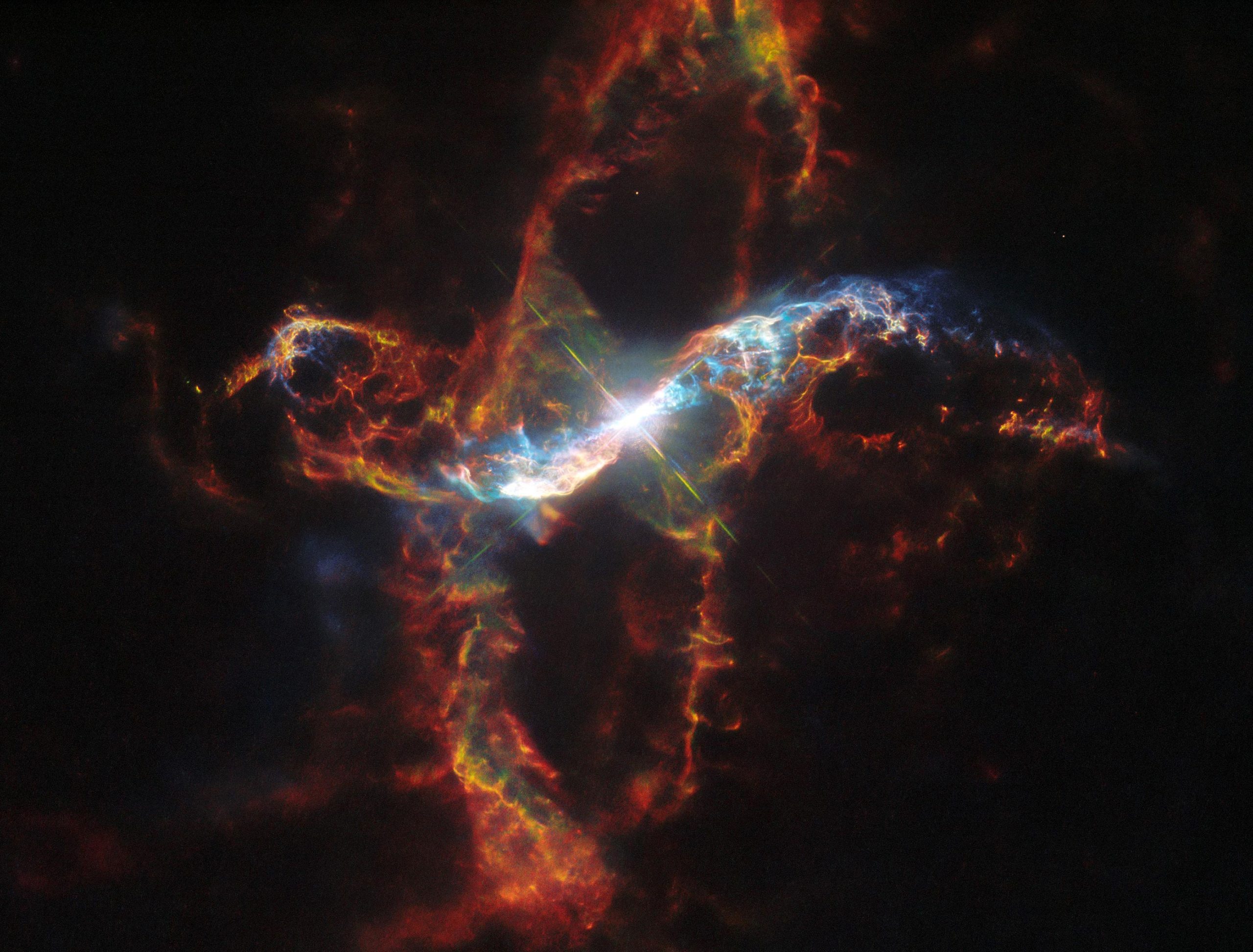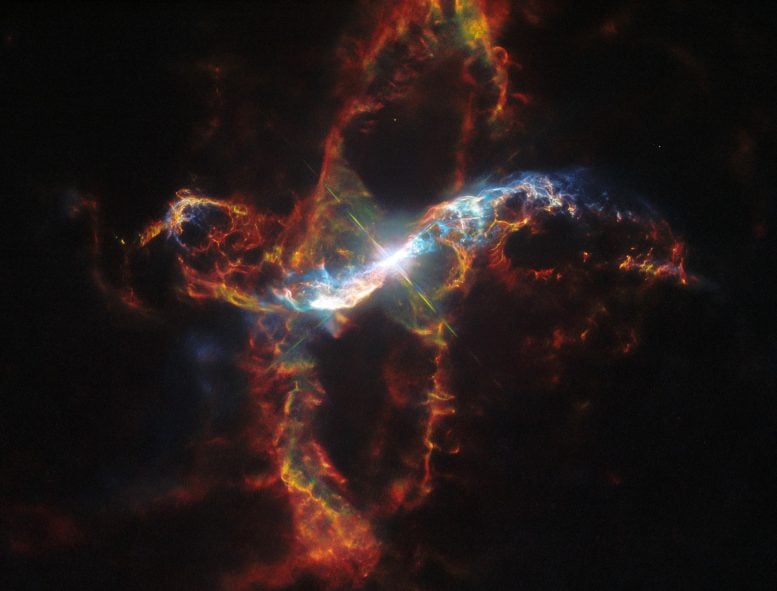

Oddball Stellar Duo Creates Spectacular Fireworks
Located about 700 light-years from Earth, R Aquarii is one of the closest stars known to undergo massive violent eruptions that spew out huge quantities of processed nuclear material into the surrounding space. R Aquarii belongs to the symbiotic class of 150 known variable stars. The symbiotic classification borrows its name from the word “symbiosis” in biology, whereby two different types of organisms co-exist. In astronomy, a symbiotic system is composed of two very different types of stars: a cool red giant star and a small white dwarf companion (a hot burned-out star). They are embedded inside a glowing nebula produced by gas escaping the red giant.
In 1939, Edwin Hubble first detected the expansion of this nebula. In the 1970s astronomers found jets of matter streaming in opposite directions – resembling a lawn sprinkler. Astronomers now know R Aquarii has actually experienced a series of violent eruptions – the latest one probably occurring in the late 1970’s. This happens when the dwarf star swings close to the red giant primary star, siphons off hydrogen, and then the dwarf star undergoes a spontaneous thermonuclear explosion on its surface. Since 1990, the Hubble Space Telescope has been observing R Aquarii, and its latest images reveal colorful, twisted filaments stretching far from this unusual stellar duo, resembling the patterns made by a child’s Spirograph toy.
This video features five frames spanning from 2014 to 2023 of R Aquarii. These frames show the brightness of the central binary changing over time due to strong pulsations in the red giant star. The central structures spiral outward due to their interaction with material previously ejected by the binary. This timelapse highlights the value of Hubble’s high resolution optical observations in the changing universe, known as time-domain astronomy. Credit: NASA, ESA, Matthias Stute, Margarita Karovska, Davide De Martin, Mahdi Zamani, N. Bartmann (ESA/Hubble)
Hubble Space Telescope Sees a Stellar Volcano
NASA’s Hubble Space Telescope has captured a vivid close-up of one of the most active stars in our galaxy, weaving a huge spiral pattern among the stars.
Located about 700 light-years from Earth, the binary star system known as R Aquarii experiences violent eruptions that blast out huge filaments of glowing gas. These twisted outflows of stellar material make the area resemble an out-of-control lawn sprinkler. This dramatic and colorful display illustrates how the universe redistributes the products of nuclear energy from deep within stars, ejecting it back into space.
Stellar Mechanics of R Aquarii
R Aquarii belongs to a class of double stars called symbiotic stars. The primary star is an aging red giant and its companion is a compact burned-out star known as a white dwarf. The red giant primary star is classified as a Mira variable that is over 400 times larger than our Sun. The bloated monster star pulsates, changes temperature, and varies in brightness by a factor of 750 times over a roughly 390-day period. At its peak, the star is blinding at nearly 5,000 times our Sun’s brightness.
When the white dwarf star swings closest to the red giant along its 44-year orbital period, it gravitationally siphons off hydrogen gas. This material accumulates on the dwarf star’s surface until it undergoes spontaneous nuclear fusion, making that surface explode like a gigantic hydrogen bomb. After the outburst, the fueling cycle begins again.
This video features five frames spanning from 2014 to 2023 of R Aquarii, a symbiotic binary star that lies approximately 700 light-years from Earth in the constellation Aquarius. These frames show the brightness of the central binary changing over time due to strong pulsations in the red giant star. The central structures can also be seen to be spiraling outwards due to their interaction with material previously ejected by the binary. Credit: NASA, ESA, Matthias Stute, Margarita Karovska, Davide De Martin, Mahdi Zamani, N. Bartmann (ESA/Hubble)
Dramatic Eruptions and Stellar Evolution
This outburst ejects geyser-like filaments shooting out from the core, forming weird loops and trails as the plasma emerges in streamers. The plasma is twisted by the force of the explosion and channeled upwards and outwards by strong magnetic fields. The outflow appears to bend back on itself into a spiral pattern. The plasma is shooting into space over 1 million miles per hour – fast enough to travel from Earth to the Moon in 15 minutes! The filaments are glowing in visible light because they are energized by blistering radiation from the stellar duo.
Hubble first observed the star in 1990. R Aquarii was resolved into two very bright stars separated by about 1.6 billion miles. The ESA/Hubble team now has made a unique timelapse of R Aquarii’s dynamic behavior, from observations spanning from 2014 to 2023. Across the five images, the rapid and dramatic evolution of the binary star and its surrounding nebula can be seen. The binary star dims and brightens due to strong pulsations in the red giant star.
Extending Astronomical Boundaries
The scale of the event is extraordinary even in astronomical terms. Space-blasted material can be traced out to at least 248 billion miles from the stars, or 24 times our solar system’s diameter. Images like these and more from Hubble are expected to revolutionize our ideas about such unique stellar “volcanoes” as R Aquarii.
The Hubble Space Telescope has been in operation for over 30 years, consistently making groundbreaking discoveries that deepen our understanding of the universe. Hubble is a collaborative project between NASA and the European Space Agency (ESA). NASA’s Goddard Space Flight Center in Greenbelt, Maryland, oversees the telescope and its mission operations, with support from Lockheed Martin Space in Denver, Colorado. The Space Telescope Science Institute in Baltimore, Maryland, manages Hubble’s scientific operations for NASA, and is operated by the Association of Universities for Research in Astronomy.